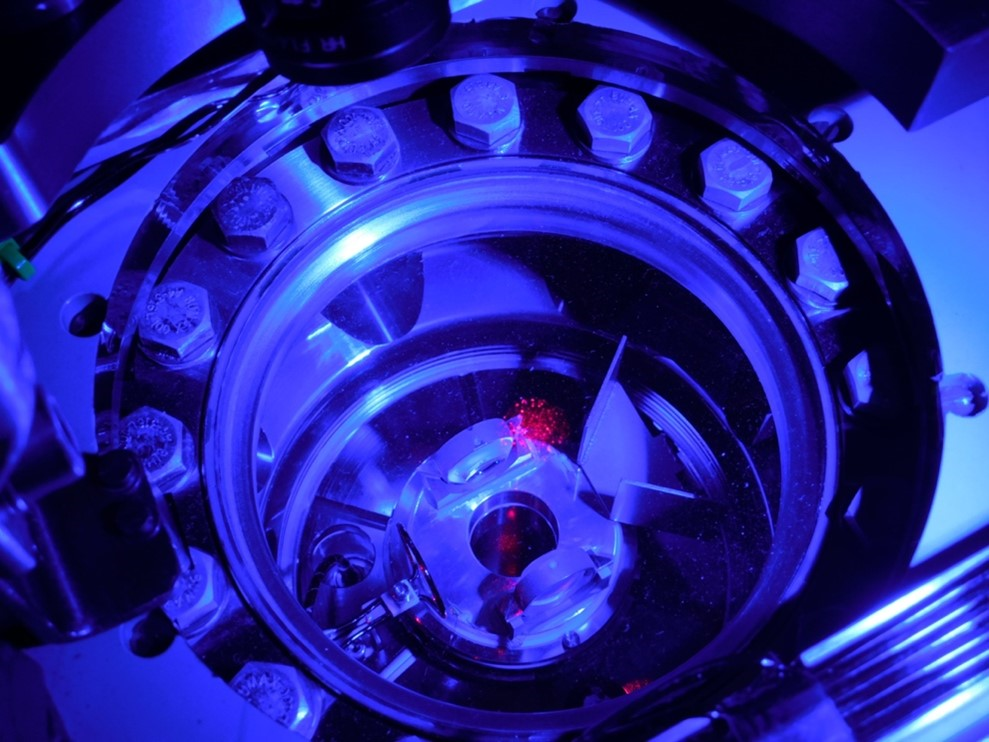Laser-Based Tuning of Light–Matter Interactions
The behavior of complex quantum systems, such as new and exotic phases of matter, can be studied by simulating them with clusters of interacting atoms held in a trap. Controlling the interactions between atoms is often difficult, but one way to do this is by controlling the atoms’ coupling to photons, which can mediate the way the atoms interact with one another. A team in Switzerland has now demonstrated a laser-based technique that can tune the coupling that the atoms have with photons inside an optical cavity [1]. This light-driven control knob has the advantage that the researchers can target where in the cavity they tune the atom–photon coupling. In this way it should be possible to “program” groups of atoms for specific quantum simulations, as well as for quantum information applications.
In an optical cavity, light bounces back and forth between two mirrors, one at each end of a chamber. Interference effects set up a standing-wave light field—an optical mode—with a particular shape and wavelength. If there are atoms inside the cavity, they can undergo transitions between quantum states of their electrons if the energies of photons of the optical mode match those of these electronic transitions. Such transitions can alter how the atoms interact with one another.
The light–matter interactions are generally governed by the geometry of the cavity, since this determines the optical mode. To be able to vary and control these interactions, researchers have previously explored approaches such as changing the distance between mirrors [2] or physically moving the atoms in and out of the cavity [3]. Francesca Orsi and co-workers at the Swiss Federal Institute of Technology in Lausanne (EPFL) have developed a more versatile and less cumbersome method in which a laser beam shone onto selected small groups of atoms in a trapped cloud can modify their coupling strength with the light field inside the cavity.
The researchers use so-called Floquet engineering, where the intensity of the control beam is modulated in a time-periodic manner that delivers a series of optical “kicks” to the atoms. These kicks can alter the energies of the electronic states, “detuning” them out of resonance with the cavity mode. Orsi and colleagues demonstrated the method on a cloud of around 300 lithium atoms optically cooled to a temperature of about 500 µK.
The basic idea of using light to detune the atom–photon coupling has been explored before, but only for all the atoms held in a cavity [4, 5]. Orsi and colleagues, in contrast, use a lens and a spatial light modulator—a grid of elements that shifts the phase of the light waves—to direct the control beam onto specific regions of the cloud of atoms so that only some of them are affected.
“We can decide at which point in space the atoms feel the modulation,” says Orsi. The shape of the control beam can be given an arbitrary form by the light modulator. This shaping capability could ultimately enable the researchers to build a wide range of patterns of interaction between the atoms and thus to simulate various types of quantum many-body systems. “Changing the shape of the light–matter interaction in the cavity means that, in principle, we can fully control the shape of the effective interaction between atoms,” Orsi explains.
The researchers demonstrated Floquet engineering of the lithium-atom cloud by detuning the electronic transitions—effectively switching off the light absorption—for atoms in regions just a few micrometers across. The results show that the atom–photon coupling does not need to be dictated by the geometry of the cavity “but can instead be shaped in space and time in a programmable fashion,” according to the researchers.
The system “has great potential for studying many-body physics and quantum information processing with many atoms,” says Tiancai Zhang of Shanxi University in China, whose group also works on controlling light–matter interactions in cavities [5]. “This is a highly innovative method,” says Tilman Esslinger, a quantum-optics specialist from the Swiss Federal Institute of Technology (ETH) Zurich. Going beyond this proof of concept, he foresees the method being used to engineer atom–atom interactions and thus replicate the connections that pertain in complex quantum systems.
–Philip Ball
Philip Ball is a freelance science writer in London. His latest book is How Life Works (Picador, 2024).
References
- F. Orsi et al., “Cavity microscope for micrometer-scale control of atom-photon interactions,” PRX Quantum 5, 040333 (2024).
- A. J. Kollár et al., “An adjustable-length cavity and Bose–Einstein condensate apparatus for multimode cavity QED,” New J. Phys. 17 (2015).
- M. Khudaverdyan et al., “Controlled insertion and retrieval of atoms coupled to a high-finesse optical resonator,” New J. Phys. 10 (2008).
- L. W. Clark et al., “Interacting Floquet polaritons,” Nature 571 (2019).
- Y. Liu et al., “Realization of strong coupling between deterministic single-atom arrays and a high-finesse miniature optical cavity,” Phys. Rev. Lett. 130 (2023).





